Folks, get into warrior pose, because I have some bad news. It’s slim pickings in the world of eco-friendly, non-toxic yoga mats. Here are the best of the bunch.
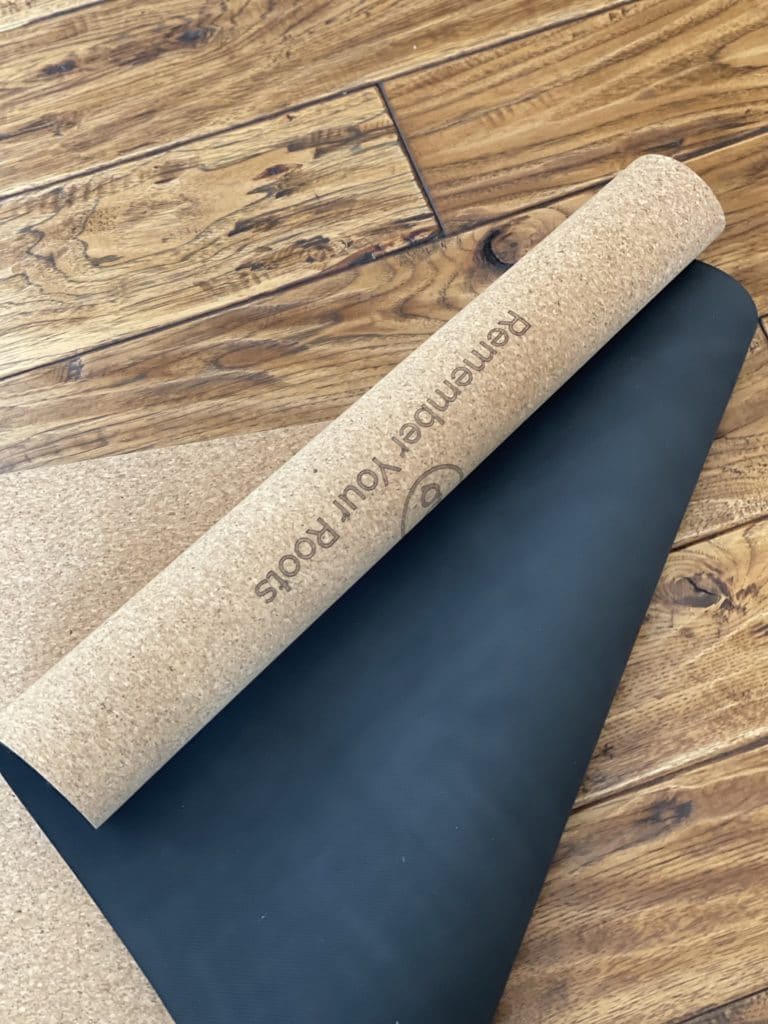
Isn’t yoga meant to be a mindfulness practice? Frankly, I can’t think of many things less conducive to a clear mind and a healthy body than breathing in toxic VOCs while you practice your asanas, and yet most yoga mats are made with petroleum products that off-gas terribly and break down fast.
So, what to do if you’re looking for a safe, non-toxic yoga mat made by a company that cares? Thankfully, a handful of companies do have their act together, with options featuring natural rubber, cork, cotton, and wool below.
Curious about how we rate products? Click here to view our methodology, which is, at its core, about voting with our dollars to fight climate change.
A note on materials
Most yoga mats comprise polyvinyl chloride (PVC), thermoplastic elastomer (TPE) or some other synthetic material. You’re also likely to find the following in yoga mats:
- Polyurethane
- Polyester
- Conventional cotton
- SBR (styrene butadiene rubber – AKA synthetic rubber).
Mats made with these materials can expose you to endocrine disrupting chemicals and carcinogens, including BPA, phthalates, and other chemicals of concern. This is because of the materials themselves and because manufacturers often add plasticizers, dyes, UV treatments and fire retardants to the mats.
These chemicals and materials are problematic at all stages of a product’s life, from resource extraction (fossil fuels), through manufacturing, to use, and at disposal. In fact, when a mat manufacturer says its PVC or TPE mat is recyclable, it’s usually not. Why? Because the added chemicals, plus dirt from use, contaminates the recyclable materials, making it difficult, expensive, or just plain impossible to recycle or even downcycle.
The healthier and more sustainable option, then, is a mat made with natural materials that don’t harm people or planet at any stage of their lifecycle. The best natural yoga mat materials include:
- Natural rubber (latex)
- Cork
- Cotton
- Wool.
These all have their pros and cons, with cork and natural rubber offering the best grip and performance for most yoga practitioners.
Our top picks
As you’ll see below, Prolana’s mats, Brentwood Home’s mats, and Green Earth’s yoga mats carry with them a ton of certifications, including from Forestry Stewardship Council (FSC), GOTS, Fair Rubber, QUL, Eco Institut, kbA, and kbT.
For those of us in North America, Gurus Roots Cork (Roots) Yoga Mat (view on Amazon) is the best eco-friendly yoga mat around. Unfortunately, this high-performance, durable, eco-friendly mat is consistently out of stock. The Leaf Score team has thoroughly tested this mat, though, and love it, which is why we still recommend it if you happen upon one.
- Made from natural rubber and cork
- Excellent grip, especially for hot yoga
- Reversible – cork and rubber layers allow for versatile use
- Company partners with Trees For the Future to plant trees
- Cork is naturally antimicrobial
- 5 pounds, despite being thin, could be considered heavy to some
- Cork is subject to cracks when folded
Gurus Roots yoga mat at a glance:
- Length: 72 inches
- Width: 25 inches
- Thickness: 5 mm
- Weight: 6.25 lbs.
- Materials: Natural rubber, cork
- Certifications: n/a
The Gurus Roots mat has been our top pick for a long time, and is beloved by the Leaf Score team. It’s consistently out of stock though, so if you see it in stock, grab it while you can! And if you like the look of it but it’s unavailable, consider the b.halfmoon cork mat instead, which is very similar in composition and size.
Gurus offer two Natural Cork Mat options, the Roots Yoga Mat which has a natural rubber base layer, and the Sprout mat that is made with TPE. As such, the Roots Mat makes the Leaf Score cut, but the Sprout does not.
The Gurus Roots mat is a versatile reversible mat that offers excellent grip for sweatier sessions (cork side) and a cooler (rubber) side for calmer practice.
Cork naturally absorbs moisture, meaning that you won’t need to use a towel on top of this mat, making it even easier to take your practice with you when you travel. That said, the mat does weigh in at about 5 pounds, despite being quite thin. This is still much lighter than most regular rubber mats, though (the Manduka eKO is 7 pounds).
Gurus mats are made with natural, sustainably sourced cork and rubber, some of which is tapped right on the family farms of the company’s creators in Kerala, India.
The company is clearly committed to environmentally-friendly practices and has partnered with Trees For The Future, a non-profit that plants trees with rural communities in the developing world, enabling them to restore their environment, grow more food, and build a sustainable future. For every Gurus product purchased, Trees For The Future plant a tree.
Cork is naturally antimicrobial (making this mat a breeze to care for), and it doesn’t absorb heat, so you can use this mat for outdoor yoga in the sun (cork side up). Just be sure to roll this mat instead of folding it, so you don’t risk cracking the cork.
The Roots mat offers a good balance between comfort and stability as it is firm but forgiving on the joints.
Our experience with Gurus
This is the yoga mat used by some of our team members. We have used the mat for two years, and have been impressed with durability. Both the rubber and cork sides of the mat are usable, depending on how sweaty your yoga sessions get.
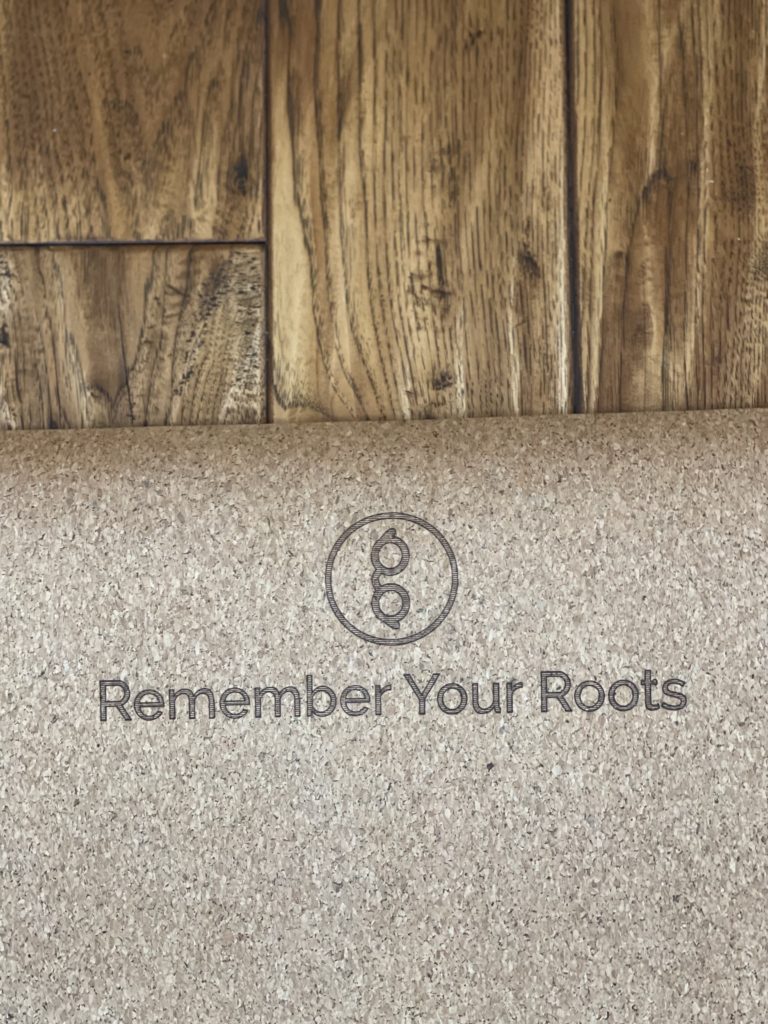
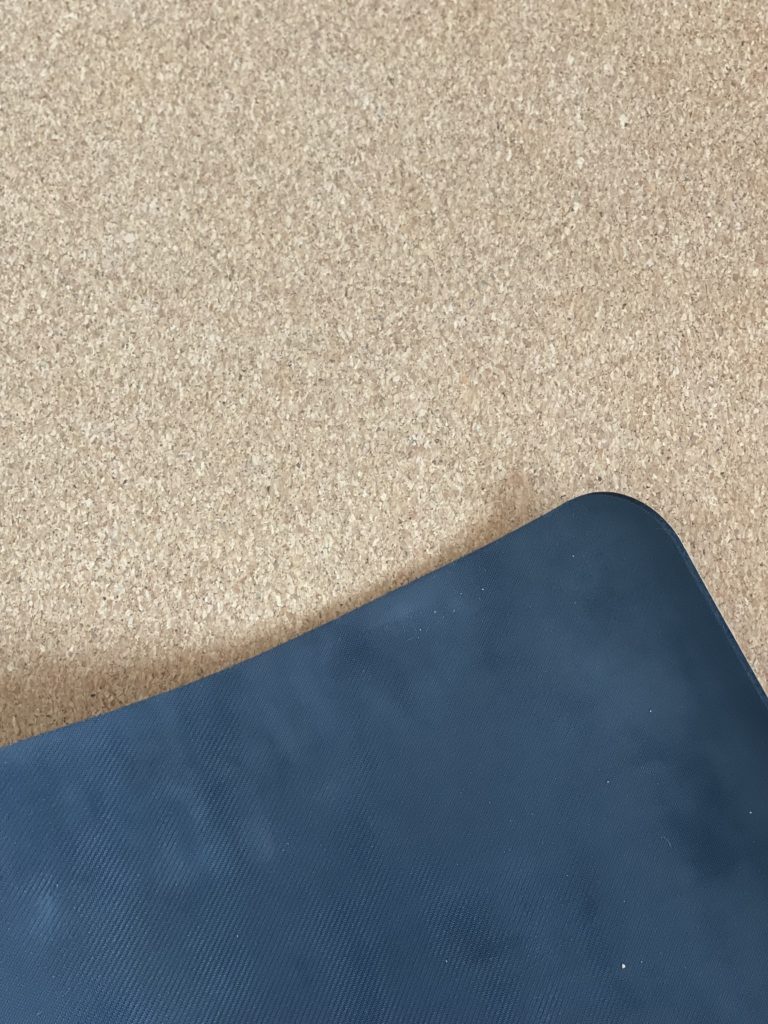

- One of the only GOTS organic cotton and FSC certified yoga mats available
- Climate Neutral Certified and certified Vegan
- Thick enough to support lunges but not so thick to throw you off balance
- Light
- Machine washable
- Technically machine washable, but a bit bulky for smaller machines
- Not reversible
- You can’t give it a quick wipe down like an all-rubber mat
Brentwood Home yoga mat at a glance:
- Length: 71 inches
- Width: 24 inches
- Thickness: 5 mm
- Weight: 5.7 lbs.
- Materials: Natural Dunlop latex (rubber), organic cotton
- Certifications: Vegan (by Vegan Action), Climate Neutral Certified, GOTS, FSC natural rubber
Brentwood Home offers the only yoga mat I’ve found with a comfy GOTS certified organic cotton upper and a non-slip FSC certified natural rubber base for grip. This mat is totally non-toxic, vegan-certified (by Vegan Action), biodegradable, machine washable, and measures 5 mm thick, 71 inches long and 24 inches wide. It weighs just 5.7 lbs. though, making it light enough to tote across town to class.
Thanks to the absorbent upper woven organic cotton fabric, there’s no need to wipe down the mat. This yoga mat is also a great fit for:
- Hot yoga
- Anyone with tender joints who enjoys more cushioning.
Brentwood Home’s Dunlop latex is FSC® certified and comes from sustainably managed rubber tree plantations. The organic cotton is also certified to the Global Organic Textile Standard, meaning it’s grown without pesticides, herbicides, or chemical fertilizers that harm the environment and human health.
These mats are:
- Totally naturally
- Fully biodegradable
- Easily recycled or upcycled.
Brentwood Home is Climate Neutral, measuring and offsetting its entire operations’ carbon emissions. The company uses 100% renewable energy at its factory and is an Avocado Green Brands business, all of which are Climate Neutral Certified.
The mats are free from:
- Polyurethane
- EVA foam
- PVC
- TPE
- Synthetic rubbers
- Toxic adhesives.
These yoga mats are made in India and come in six gorgeous colors. They’re easy to care for as you can just air it out then roll it up when done. Or spot clean it or throw it in the washing machine if it needs more robust cleaning (and to reinvigorate the cotton pile). Line dry or machine dry.
- Eco-friendly, made with natural rubber and cork
- Excellent grip (when damp)
- Variety of designs and mat sizes/thicknesses
- Ships plastic-free
- Woman-owned Canadian company
- No certifications
- Waitlist for some designs
Scoria yoga mats at a glance:
- Length: 72 inches (options available up to 80 inches)
- Width: 24 inches (options available up to 28 inches)
- Thickness: 4.5 mm (with options for mats 2-6 mm thick)
- Weight: 5.7 lbs.
- Materials: Cork, natural rubber (carrying strap comprises 50% polyester, 50% organic cotton)
- Certifications: n/a
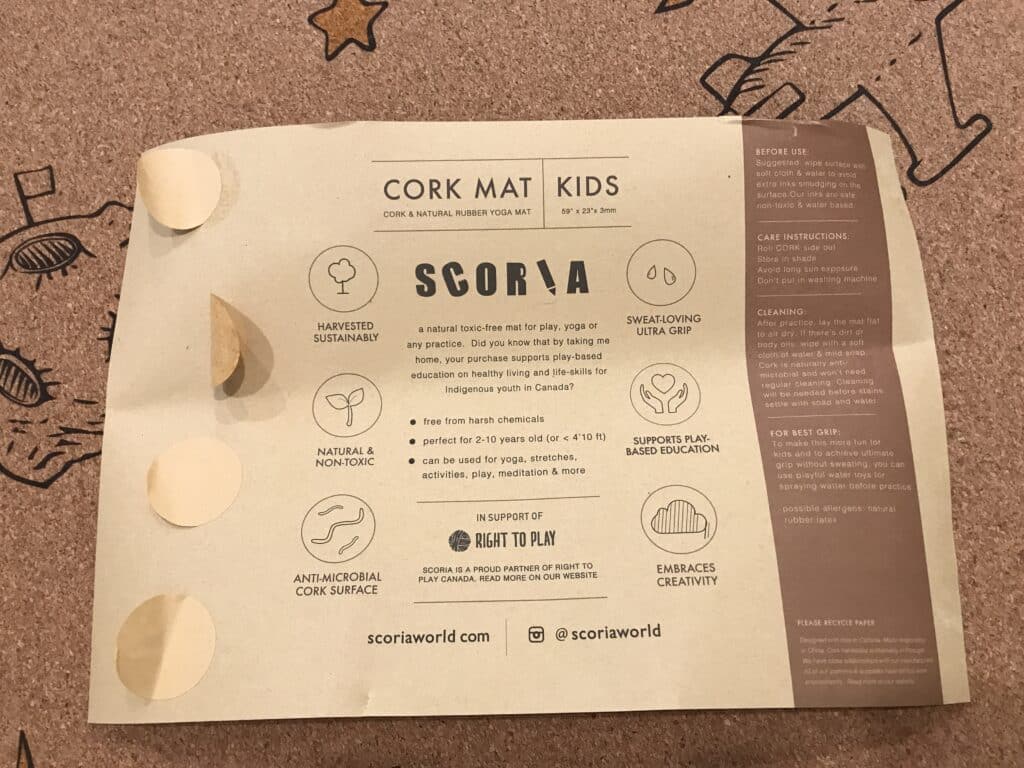
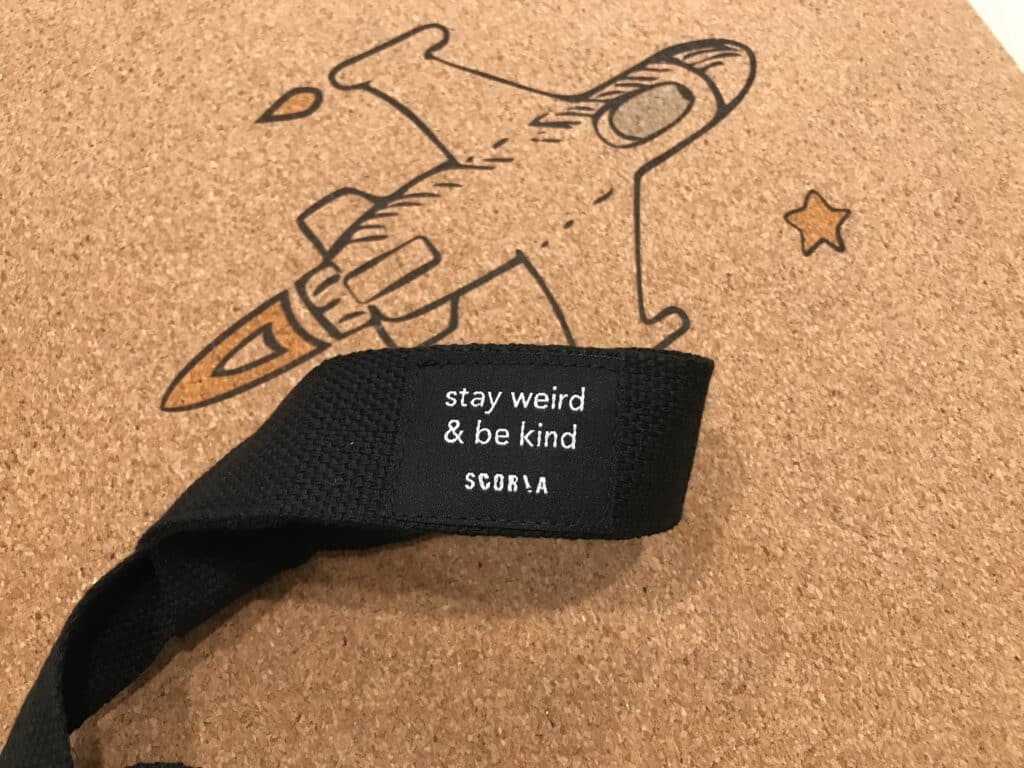
Scoria offers a wide variety of mat designs, all made with sustainably sourced cork (from Portugal and Vietnam), backed with natural rubber. Even the dyes are eco-friendly, water-based, and non-toxic.
The company doesn’t use any toxic adhesives to make its mats. Instead, Scoria uses water-bases, non-toxic glues and high temperatures to stick the cork to a natural base cloth between the cork and rubber. Even the packaging is plastic-free, with paper stickers used to wrap the info sheet around the mat.
Most of the Scoria mats are 4.5 mm thick and come with a carrying strap made of 50% polyester and 50% organic cotton. Some mats are thicker, and some wider and longer.
Scoria is a great choice for mini yogis. The Scoria Kids’ Yoga Mats are non-toxic, eco-friendly, and super fun! My favorite is the Space yoga mat (View on Earth Hero, View on Scoria).
My Space Mat arrived plastic-free and had no detectable odor on unboxing. That means it was good to go right away. My toddler pretty much clawed the box open to get to it (hence the rushed photos!). It was an immediate hit, both for yoga and playtime. I really like how the design lets you help your kid through movements by asking them to put their right hand on Saturn or their foot on a comet. It’s like space-Twister-yoga!
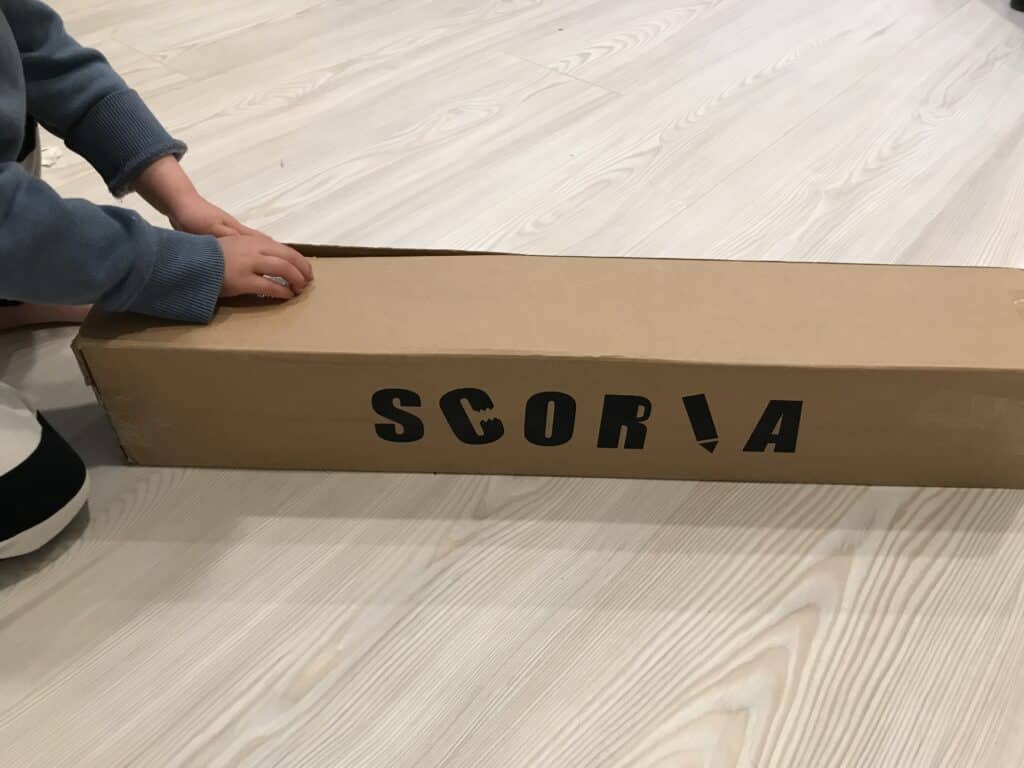
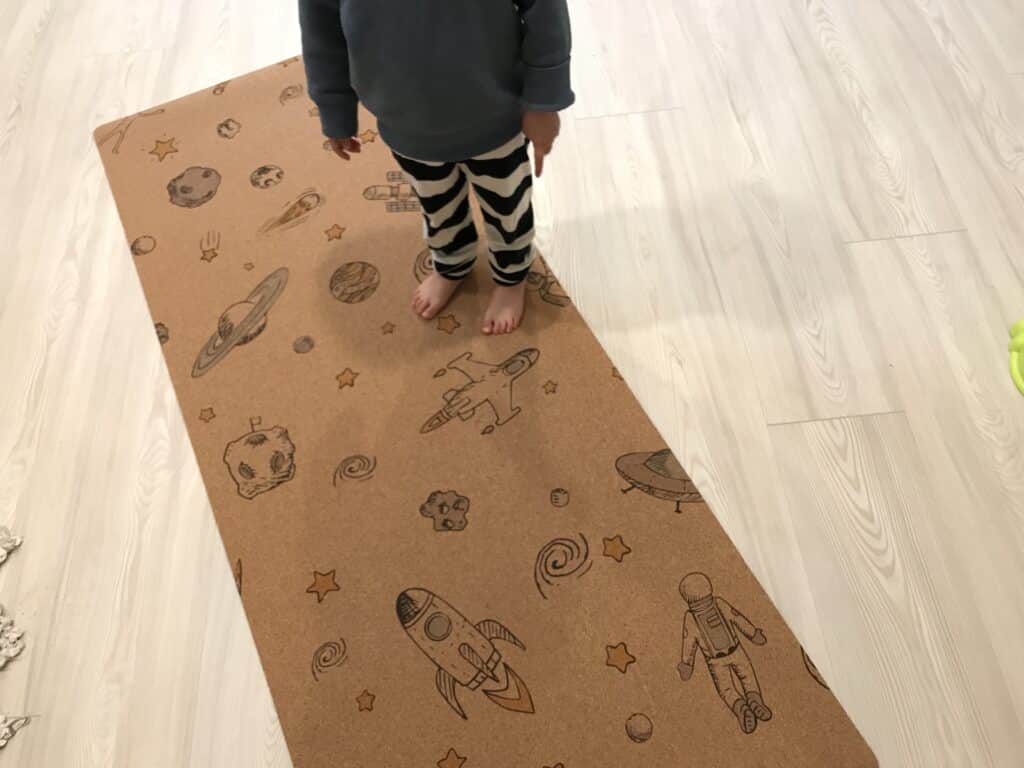
The surface had plenty of grip even without spraying it with water. My kid loves to play with water though, so we have already had some fun giving it a spritz before use.
At 5 foot 6 inches, this mat is a little short for me, but only just. My mom is just over 5 foot tall though and it’s proven a great size for her to do yoga and stretches while visiting this spring. The strap is super easy to use and works really well, and I love that it’s not unnecessarily bulky or ostentatious.
The mat seems to be great quality, with no signs of rips or tears even after some robust toddler (and adult) use. One thing I have noticed, though, is that the rubber side picks up dirt and hair quite quickly. So, if you have a dog or cat at home, expect to need to vacuum or lint roll this mat (and any other rubber mat too).
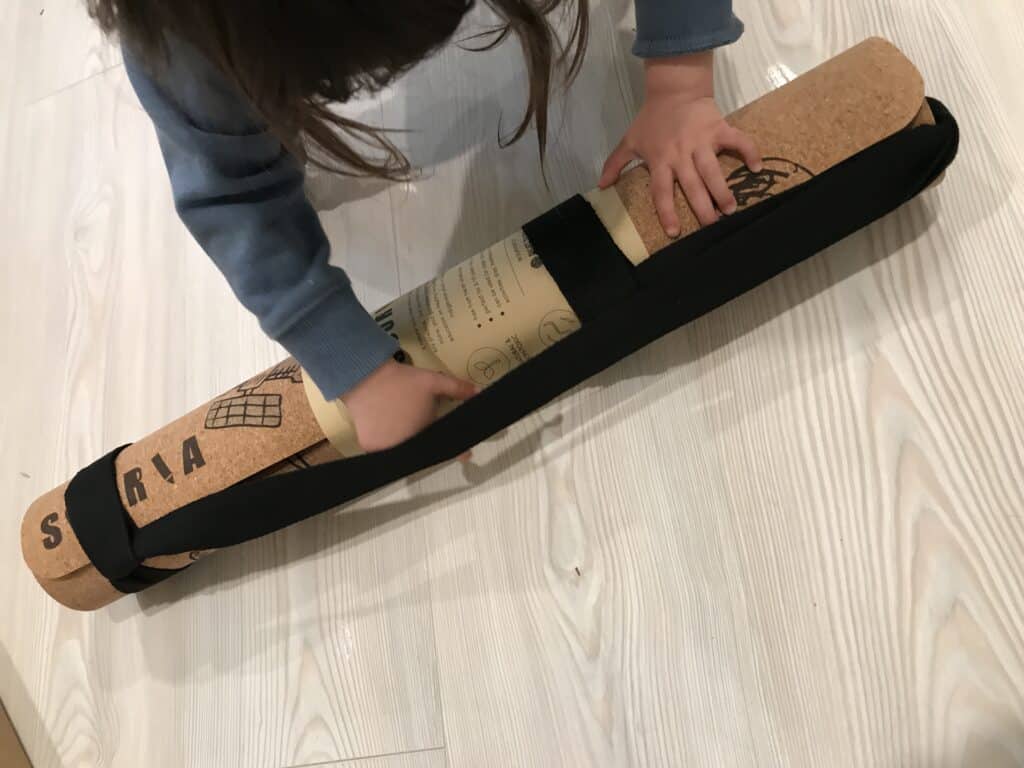

Scoria is also community minded, donating 10 meals for each mat sold, through Feeding Children Everywhere. And if you’re looking for yoga accessories, Scoria offers sustainable, non-toxic yoga blocks, meditation cushions filled with kapok or buckwheat, and other people- and planet-friendly products.
The mats and other goodies ship plastic-free from Scoria and from Earth Hero.
- Natural rubber, sustainably sourced, with some food-safe additives
- Super grippy
- Easy to clean
- Durable
- Long and available in extra wide version
- Affordable!
- Made by a longstanding, eco-friendly company
- Every purchase plants trees
- Heavy
- Has lingering natural rubber smell
- Not for outdoor yoga
- No certifications or third-party testing available
Jade Harmony yoga mat at a glance:
- Length: 80 inches (standard) / 80 inches (XW)
- Width: 24 inches (standard) / 28 inches (XW)
- Thickness: 4.7 mm
- Weight: approx. 5 lbs. (standard) / 7 lbs. (XW)
- Materials: 100% natural rubber
- Certifications: Trees for the Future (partner)
Jade uses 100% natural rubber to make its most popular yoga mat, the Harmony. This is now available in an extra wide version and both are very long, at 80 inches. The Harmony is a great mat for everyday use, whether for yoga, Pilates, or other kinds of workout.
Jade also offers thicker and thinner rubber mats, as well as cotton yoga rugs and even a yoga rug made from recycled sari material.
If you want more joint cushioning, the Fusion mat is a great choice.
For more vigorous workouts, the Elite S mat is a good option as it has an extra dense layer.
The Travel and Voyager mats weigh in at just 3 lbs. and 1.5 lbs. respectively and are great for yoga on the go.
There’s even a Mini mat perfect for adding cushioning to your regular mat or for use as a children’s yoga mat.
Jade’s precise recipe for its rubber mat mixture is proprietary. All the company reveals is that it uses sustainably tapped natural latex as part of a mixture containing “both natural and man-made components”.
Jade also claims that its mats are free from:
- PVC
- Phthalates
- Heavy metals
- Flame retardants.
The company has been making yoga mats from natural rubber since 2000 and has a solid reputation for quality and durability. Its initial focus was to create a yoga mat that wasn’t slippery, and this happened to mean using natural rubber. The company’s focus on sustainability has also been consistent, with a long-term partnership with Trees for the Future resulting in more than 2.4 million trees planted already.
- Made from virgin wool and certified organic cotton
- Longer than many yoga mats
- Expensive
- Ships from Europe
- Often out of stock
- The mat has no grippy base layer, limiting the places it can be used
Prolana yoga mat at a glance:
- Length: just under 75 inches
- Width: 27.5 inches
- Thickness: n/a
- Weight: n/a
- Materials: Wool, organic cotton
- Certifications: GOTS (for cotton)
The Prolana Yoga Mat has a durable, certified organic half-Panama cotton base layer and an upper layer of soft lamb’s wool. This makes the mat ideal for those who like a little more cushioning and warmth.
The wool is also naturally:
- Antimicrobial
- Dirt-repellent
- Flame resistant.
The Prolana Yoga Mat is available in a natural color, terracotta (brick red), and anthracite (black). As it has no grippy base layer, this mat is best suited for use on carpet or outside, or on a grip mat or other yoga mat.
- Reversible 100% cork and natural rubber mat
- Fully biodegradable
- Grippy
- Wipe clean, quick-dry, and naturally antimicrobial
- 4 mm thick for a balance of cushion and lightness
- Woman owned Canadian B corporation
- Meant to least 2+ years
- No synthetic rubber or harsh chemicals
- Often out of stock
- The brand’s other mats are made of PVC and synthetic rubber
- The brand’s marketing is a little ‘greenwashy’
LeafScore readers can get 15% off their entire order at b.halfmoon! Use code LEAFSCORE15 at checkout.
b.halfmoon yoga mats at a glance:
- Length: 71 inches
- Width: 26 inches
- Thickness: 4 mm
- Weight: 5.1 lbs.
- Materials: 100% natural rubber, cork
- Certifications: B Corp
b.halfmoon offers several yoga mats, but most are made with synthetic rubber or PVC. The cork and rubber mat is the only one I recommend from the brand and is a reversible mat with a natural cork top surface and natural rubber bottom.
This mat is fantastic for hot yoga and other sweaty workouts. It has excellent grip when wet and is quick-dry, antimicrobial, and easy to care for. Any initial smell is due to the natural rubber of the mat and should dissipate with airing out.
All b.halfmoon mats come with a one-year warranty, though the company says it designs its mats to withstand use for at least two years.
b.halfmoon claims to not use any harsh chemicals, finishes, or sealants in its mats, but it doesn’t offer any third-party testing or certification to back up this claim. This newer company is a Canadian B Corp, however, which gives me greater assurance of at least some third-party auditing and adherence to good marketing practices.
b.halfmoon also offers cork yoga blocks (view on b.halfmoon) and other accessories that are eco-friendly and non-toxic.
- GOTS organic cotton mat with natural rubber backing
- Offers enough grip for most yoga practices
- Lighter than a rubber mat
- Available in lots of beautiful colors (plant dyes only)
- Ships sustainably
- Expensive
- Not robust enough for vigorous yoga, workouts, or Pilates
Öko Living yoga mats at a glance:
- Length: 72 inches
- Width: 25 inches
- Thickness: 5 mm, 6-ply cotton
- Weight: 3.4 lbs.
- Materials: Organic cotton, natural rubber, medicinal plant dyes
- Certifications: GOTS cotton
Oko Living offers its beautiful handloomed yoga mats in a variety of colors, all made with 100% GOTS Certified organic cotton with a natural rubber backing to prevent slipping. The colors come from medicinal Ayurvedic plant dyes and the mat is naturally antibacterial and antifungal, with enough grip for most yoga workouts, though perhaps not enough for vigorous Pilates or more active yoga.
This mat is handwoven in India, where the cotton and plants for dying are grown. The mat is free from:
- PVC
- BPA
- Phthalates
- Hazardous chemicals.
You can hand wash the mat or machine wash it (follow care instructions carefully!).
Unlike many cotton yoga mats, this one comes with a legitimate GOTS certification for the organic cotton. It ships plastic-free in a recyclable box from one of our favorite B Corps and 1% for the Planet members, Earth Hero.
- All natural materials
- Available scented (lavender) or unscented
- Longer and wider than most mats
- Anti-slip coating made from flax and natural latex
- Passed third-party toxicity tests
- Ethical wool certification
- No carrier or strap included
- Not vegan
- No info on weight or thickness
Green Earth Wool yoga mat at a glance:
- Length: just under 75 inches (unscented) / just under 73 inches (lavender scented)
- Width: 33.5 inches (unscented) / 27.5 inches (lavender scented)
- Thickness: n/a
- Weight: n/a
- Materials: Wool, cotton, flax fiber, natural rubber, lavender (in scented version)
- Certifications: kbT New Zealand wool
The Green Earth Wool Yoga Mat has a top layer comprising 100 percent kbT wool from New Zealand and the underside comprises an anti-slip coating made of flax and natural latex. As such, this mat offers both grip and a natural feel, with a little more absorption and texture than cotton yoga mats.
The Green Earth Wool Yoga Mat with Lavender has the added bonus (depending on your tastes) of relaxing lavender flowers interspersed in the edging. The lavender scent might be a real boon for anyone using the mat at home to do a more relaxing type of yoga or meditation. However, if you plan on using the mat in a class setting, consider the unscented Green Earth Yoga Mat (which is almost exactly the same).
The unscented mat is wide and long, making it an excellent choice for those who like a bit more space on the mat. The Lavender mat is a little narrower and slightly shorter, though still longer than many standard yoga mats.
The Lavender mat folds up and has its own cotton belt and button system. The unscented version rolls up easily and has its own cotton bias tape for quick tie-up. You’ll probably need a carrier, though, if you’re taking your unscented mat across town.
- Made from 100% natural rubber
- Comfortable and grippy
- More durable than most other yoga mats
- You may need the XL version if you’re taller than 5’9″
- Porous rubber requires more frequent cleaning
- Heavier than many mats
- Only two colors available
Hugger Mugger Para and Para XL yoga mats at a glance:
- Length: 70 inches (Para) / 78 inches (Para XL)
- Width: 24 inches (Para) / 28 inches (Para XL)
- Thickness: 6.35 mm
- Weight: 6.6 lbs. (Para) / 10 lbs. (Para XL)
- Materials: 100% natural rubber
- Certifications: n/a
The Hugger Mugger Para Rubber Yoga Mat gets good marks for sustainability and performance. It comprises 100 percent natural rubber from a non-Amazon source, is comfortable, grippy, and very durable.
The Para is shorter and narrower than many mats. It’s also thicker and heavier.
For a longer and wider version, check out the Para XL version (View Price on Amazon). I recommend this for anyone taller than 5’9″. As you might expect, the Para XL is even heavier than the standard mat.
Whichever you choose, you’ll likely want a robust carrying case or strap for your Hugger Mugger Para. Check out the Hugger Mugger Simple Sling for a good fit (View Price on Amazon).
If you don’t like cleaning your yoga mat, the Hugger Mugger Para is not for you. Like most rubber mats, this one has a porous, open-celled surface, meaning that hot yoga aficionados need to give it a good clean after each use.
You can’t get away with a half-hearted PVC mat cleaning routine with the Hugger Mugger Para as the mat will quickly begin to degrade without proper care.
That said, one side is more porous than the other, so if you are prone to sweating, make sure to pick the right side for such sessions.
You might also prefer a cork mat if your yoga routine tends to be sweaty.
Finally, the Hugger Mugger Para has a strong ‘new tire’ smell. This is normal for natural rubber, and it does wear off after a while. If you’re especially sensitive to smells, air out this mat (in the shade) for a week or so before use. Even then, the smell can linger, so you may want to choose a less smelly mat or one without rubber.
- Made with natural tree rubber from sustainable sources
- Tri-layer setup creates a good mix of grip, durability, and slip-resistance
- Doesn’t absorb moisture and bacteria like most other rubber mats
- Available in up to 13 colors (depends on version)
- Recycled packaging
- Lingering rubber smell that sometimes lasts from weeks to months
- We’d like to see more certifications to back up sustainable press
- Contains cotton and polyester
- Plastic packaging (could easily be cardboard)
Manduka eKO yoga mat at a glance:
- Length: 71 inches (eKO) / 68 inches (eKOlite) / 71 inches (eKO Superlite) – Long versions also available up to 79 inches
- Width: 26 inches (eKO) / 24 inches (eKOlite) / 24 inches (eKO Superlite)
- Thickness: 5 mm (eKO) / 4 mm (eKOlite) / 1.5 mm (eKO Superlite)
- Weight: 7 lbs. (eKO) / 4.5 lbs. (eKOlite) / 2 lbs. (eKO Superlite)
- Materials: Natural rubber, polyester, cotton
- Certifications: n/a
Manduka is a big name in yoga mats, thanks to its ever-popular ‘Black Mat’, the Manduka Pro. Unfortunately, the Pro is made with PVC. So, although it carries a lifetime guarantee and claims to be made with an emissions-free process, it doesn’t make the cut for a Leaf Score recommended product.
The Manduka eKO has similar cushioning to the Manduka Pro, but is lighter and rolls up smaller for greater portability and storage.
The Manduka eKO series mats comprise mostly natural tree rubber (plus polyester and cotton), without the use of ‘harmful plasticizers’. According to Manduka these mats are:
- Made using a zero-waste process
- Free of toxic chemicals, dyes, and phthalates
- Made with rubber from sustainable sources
- Manufactured using non-toxic foaming agents to make the rubber soft and pliable
- Reinforced with a blend of polyester and cotton.
The Manduka eKO mat features tri-layer technology that creates a mix of grip, durability, and slip-resistance. A stretch-resistant center binds the two layers together to improve durability.
This rubber mat is popular for its super grippy performance. The ‘tread’ of the mat helps keep it dry and gives it plenty of traction.
We don’t recommend the Manduka eQua Yoga Towel (View Price on Amazon). This towel is made of virgin microfibers, so isn’t at all eco-friendly.
One big difference between most rubber yoga mats and the eKO mat is that this one has a sealed-cell surface. That means it doesn’t absorb moisture (and harbor bacteria) like open-cell rubber mats. Overall, compared to open-cell rubber mats, the eKo is:
- More hygienic
- Easier to clean
- More durable.
The eKO seems to have more of an issue with a lingering rubber smell than the Hugger Mugger and other mats. Even if you air the mat out (not in direct sunlight) and clean the mat regularly, it might still take weeks or months for the smell to dissipate. The smell can also transfer to your hands and body. Thankfully, the natural rubber smell is not as bad as that of synthetic rubber, but this mat is a poor choice if you’re sensitive to smells.
This mat is heavy! If you’re looking for a smaller or lighter mat, check out the Manduka eKOlite (View Price on Manduka, View Price on Amazon) or eKO Superlite (View Price on Manduka, View Price on Amazon).
Pair your eKO mat with the Manduka Journey On Commuter Yoga Mat Strap for easier portability and extra eco-cred (View Price on Manduka, View Price on Amazon). This strap system is lightweight and sustainable, and is made using recycled bottles, requiring 66 percent less energy to produce, according to the company.
The carrier can fit all mats, has an easy gravity cinch closure, and features a padded shoulder strap for comfort. Manduka also make yogitoes from recycled plastic bottles.
While Manduka mats are ever-popular and the company talks a good talk about eco-friendliness, it is disappointingly thin on certifications and evidence for sustainability claims. The brand asserts that it is all about making a ‘world of difference’, so it’s hard to understand why there’s little transparency over mat materials.
Manduka offers no third-party test results for its mats and no data or certifications to back up company claims to be zero-waste and non-toxic.
On the plus side, Manduka does give back to the community, with a recent partnership helping to raise money for the Susan G. Komen organization which helps support people with breast cancer. It would be nice to see third-party testing of Manduka products, though, to verify that the mats and accessories are free from carcinogens.
What not to buy
There’s a lot of greenwashing in the yoga industry. Many ‘natural’ or ‘eco-friendly’ mats are anything but.
Take, for example, the Lululemon Mat. Made with FSC certified rubber, this mat looks to be a great sustainable choice… until you dig into the details. To its credit, Lululemon actually lists the composition of the mat, which most companies don’t.
The Mat from Lululemon comprises:
- 55% Natural rubber
- 23% Synthetic rubber
- 15% Polyurethane
- 5% Polyester
- 2% Nylon.
This is why The Mat doesn’t make the Leaf Score cut.
I strongly suspect that many other companies offering ‘rubber’ mats use a similar recipe. As such, I suggest contacting a company to ask for a full breakdown of mat materials before purchase. This helps you to know what’s in a mat and helps the company know that its potential customers expect better in terms of sustainability and mindfulness.
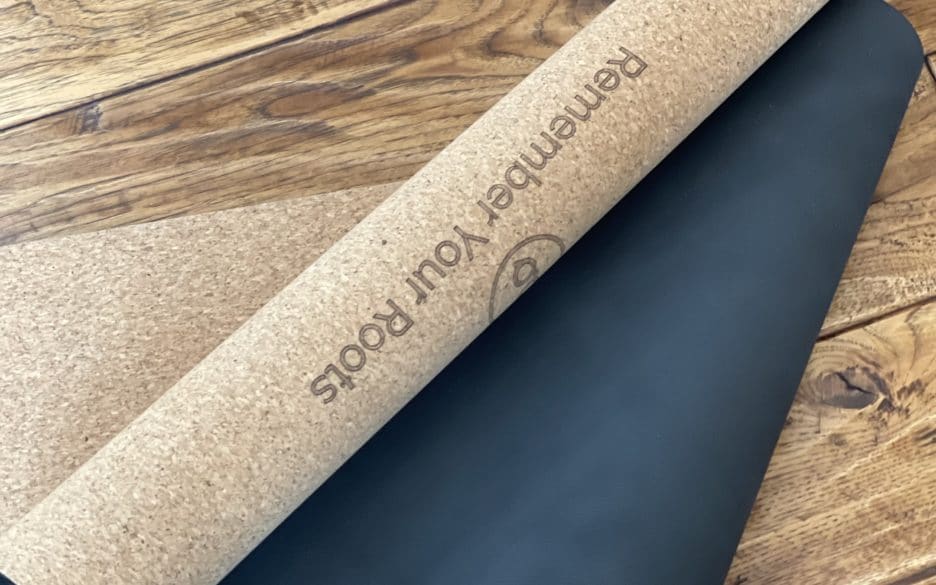
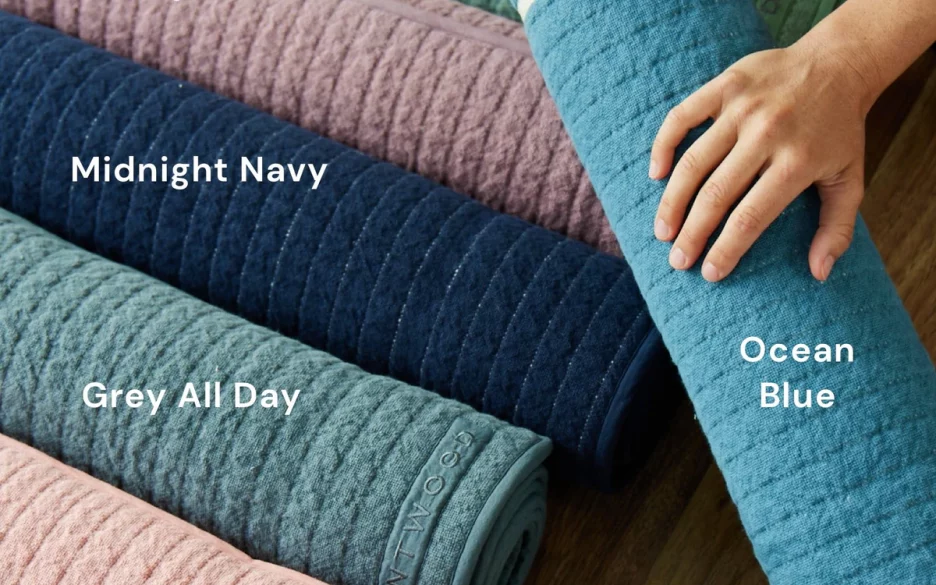
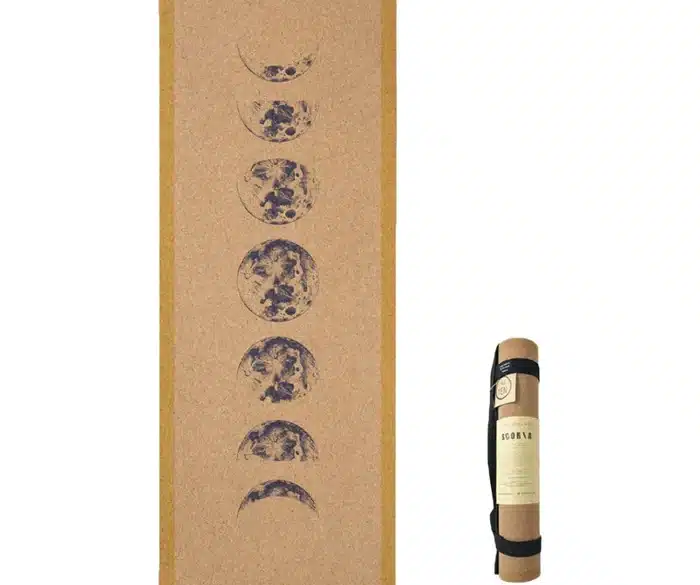

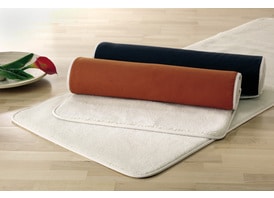
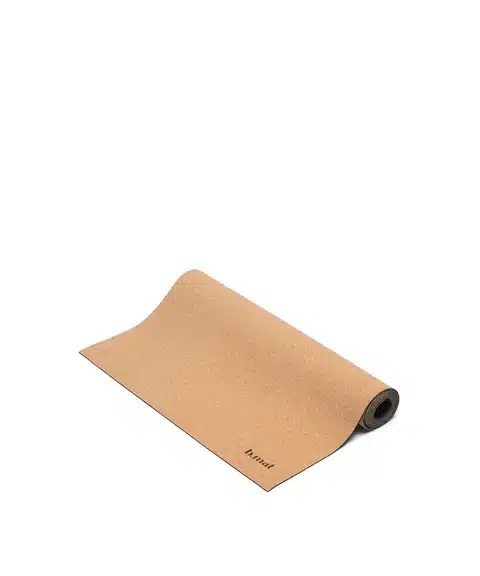
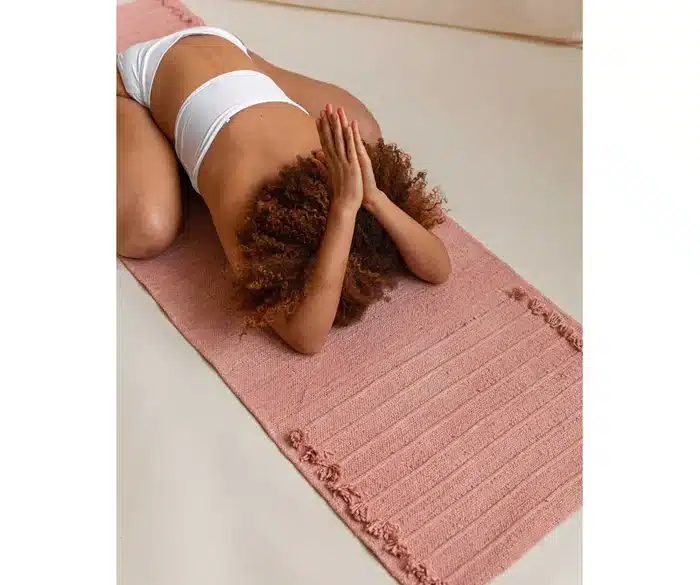
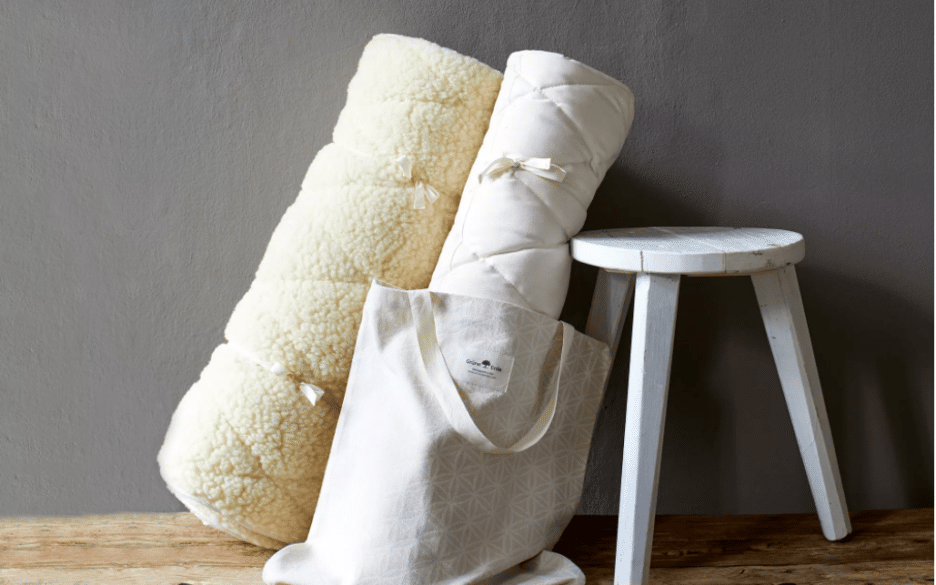
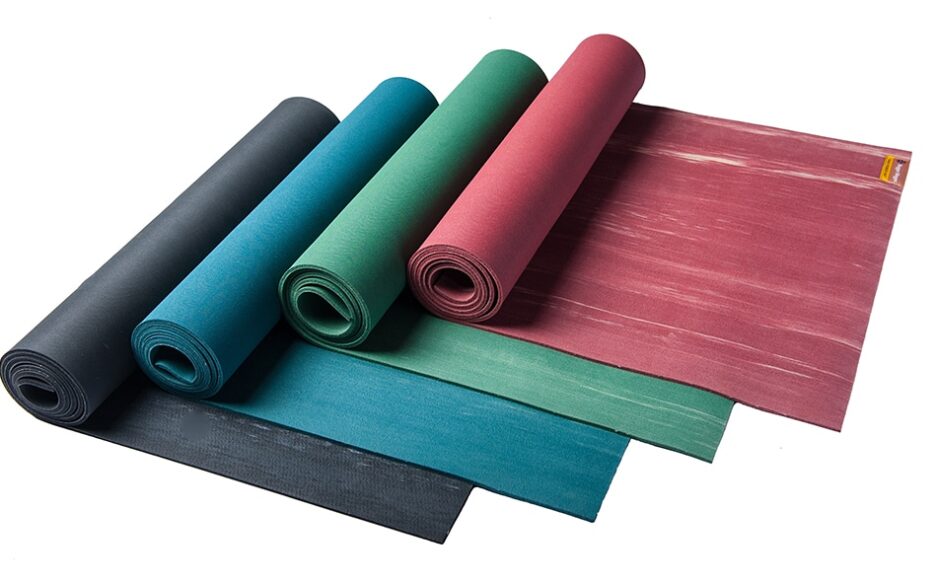

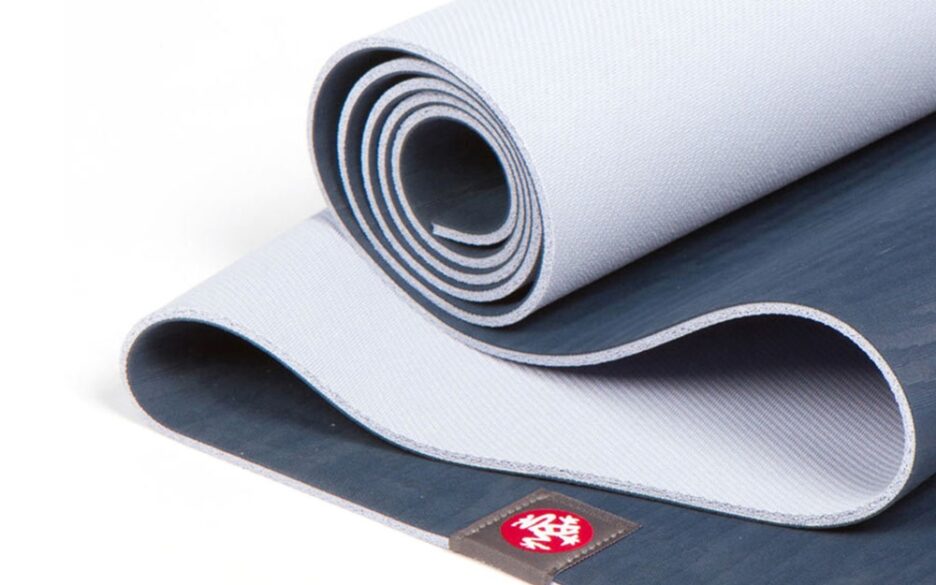
Hi Leigh,
Can you comment on B mats?
Thanks,
Anne
Hi Anne,
Thanks for the question. I took a quick look at B Yoga mats and it seems most are made with 100% rubber. This might sound good, but some more digging reveals that they use a mix of natural and synthetic rubber, so these are not non-toxic mats. Their cork and rubber mat falls foul of the same unspecified mix of natural and synthetic rubber. The company also uses polyurethane and acrylonitrile butadiene styrene (ABS) in their other products, which doesn’t fill me with confidence that they care about keeping products free from environmentally damaging and potentially harmful chemicals.
If they brought out an entirely natural rubber (or rubber and cork) mat, I’d take another look, assuming it had certifications to back up any claims.
Hope this helps!
Leigh
Can you comment on the Lole prima Yoga mat
Hi SK,
Looks like the Lole is made from TPE, so I wouldn’t recommend it, especially for any kind of hot yoga or other sweaty exercise.
Leigh
Hi Leigh,
I really appreciate your posts on toxins in yoga mats. It really helps me do you think you could take a look at this company [yoga matters sticky yoga mat], specifically this product. It seems like the best price, they say its 6-P Free (Phtalates, AZO, DOP, Phenol, Heavy Metals) and Standard 100 by OEKO-TEX® certified but they are made of High grade PVC (AZO, DOP, phthalate and latex free).
Hi Emmy,
As it’s made from PVC, I would still avoid this mat. PVC will break down into unhealthy dust and off-gas over time, plus it’s not eco-friendly. There are much better options available!
Thanks,
Leigh
Hi Leigh,
I’m not an expert on this but isn’t it true that a lot of cork + rubber mats use different types of glue such as polyurethane glues? Wouldn’t that be something that would off-gas or be problematic? I also just kind of wanted your opinion on this cork mat I found that claims to not use glue.
https://2ndwindhealth.com/products/cork-yoga-mat-whisper-in-the-wind
Thanks,
Andrew
Hi Andrew,
Sorry for the slow reply!
You’re right that PU glues are common in yoga mats, including those that use otherwise natural materials. So, yes, it’s great to check!
The company you cited claims to use a heat-bonding process to stick the cork to the rubber, avoiding the need for glue. In theory, this would work, but I’m a bit wary that the company doesn’t have any certifications such as GOLS for their latex. I’d reach out to them directly to ask about certifications and double-check that bonding process. I’ll also reach out.
Thanks!
Leigh
Leigh,
Sorry I didn’t receive an email saying that you responded. Thank you for your insight. I don’t need to buy a yoga mat right now. When I do if I choose this companies mat, then i’ll need to reach out and ask about GOLS and their bonding process. However that organic cotton / hemp mat you linked below from Etsy also seems pretty interesting.
Thanks,
Andrew
Hello! Love the article. Could you please weigh in on Scoria yoga mats? It states they are made of natural rubber and cork.
Hello!
One thing in particular I’d like to understand is whether all PU is bad/toxic to the body?
I’m particularly interested in the Yogi Bare Paws mat, or have been looking for a Cork mat that’s available in the UK (e.g., corkspace) but it’s difficult to know how they have been made.
I’d appreciate your comment on the above questions and any suggestions of other easy-to-clean non-toxic mats that are available in the UK!
Thank you in advance
Natalia
Hi Natalia,
A quick look at those brands makes me think there are much better options for UK yoga enthusiasts. The Prolana and Green Earth mats listed in this post are great choices and much more readily available in the UK than in North America!
Some other good options if you’re in the UK include Repose make a great yoga mat from just cork and natural rubber – no glues or plastics in sight.
There’s also a good looking hemp and organic cotton mat on Etsy that seems very popular and very eco-friendly.
Hope this helps!
Leigh
Hi Leigh.
I landed on your site while looking for information on TPE. Thank you for the primer. I have been looking for a non-toxic exercise mat and haven’t found anything to meet my needs. It needs to be thicker than a standard yoga mat since it will be used on hardwood floors. Have you come across anything like this?
Hi Tiffani,
I think the Prolana mats and the Manduka eKo have a bit more cushioning than typical yoga mats, so these are likely your best bet!
You could also layer mats – using, say, a Prolana mat on top of a Gurus Roots mat or similar.
Hope this helps!
Leigh